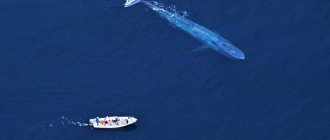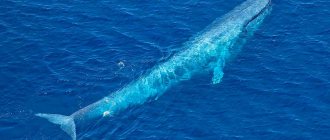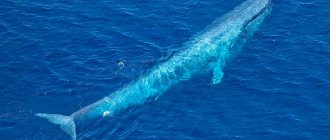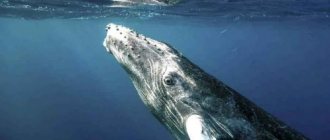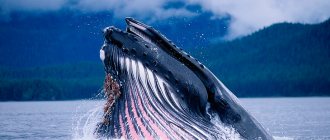The blue whale is larger in size than all other representatives of the fauna on our planet. If you look back at the history of the Earth over the past 90 million years, then during this period no other animal has appeared that could take its place. Therefore, the blue whale rightfully bears the status of the most unique creature in terms of size.
It’s a pleasure to look at this giant; his incredible size makes you admire and admire him. Record-breaking whales can be up to 33 meters long . The weight of this giant can reach up to 190 tons. However, in the vastness of the ocean such giants are very rare. Much more often you can find whales 29 meters long and weighing 130–140 tons. Usually females have this size. Males are slightly inferior to them. They are about 24–25 meters long.
Gray whale group sex
Gray whale mating is unusual in that they always reproduce during group sex. Typically, whales are divided into groups consisting of three individuals - one female and two males. While other male animals are known to fight for the right to mate with the female, some believe that a second male gray whale is present during mating to help the female get into position to facilitate mating. Whales mate near the surface, meaning their 1.5-metre penises sometimes stick out of the water in all their terrifying glory.
Helping a friend with a lady is just the beginning of how close friendships between male gray whales are. They also engage in homosexual orgies in groups of up to five males. They rub their bellies against each other, intertwine their penises, and lightly nudge each other's genitals with their foreheads. These homosexual sessions can last 90 minutes. Sex is just part of the friendship between the males, who also like to swim close to each other and have been friends in groups for several years.
Appearance
This handsome man has an elongated and graceful body . It has a wide head, which is divided into two parts. The fins located on the chest are narrow, the rear one is not impressive in size, its height does not exceed 1 meter. It is located next to the tail. As for the tail, it is wide and decorated with a rough jagged edge.
- The skin of the blue whale is dark gray with a bluish tint . The head and lower jaw differ from the rest of the body in color, which is darker. The belly is decorated with a pale yellow color. Light gray spots of various shapes and sizes can be seen on different parts of the body. Behind the jaw you can find many throat folds - up to 70.
- The mouth is large , with a searing black whalebone protruding from the upper jaw. It contains a large number of plates with a width of 50 cm and a height of 130 mm. On each plate you can see a fringe decoration; there may be about a hundred of them in total. They act as a kind of filter. Thanks to them, the whale can use its tongue to push out water, while the sea life that gets to it remains inside.
- The whale's tongue is used as a piston . Its thickness is 3 meters and its weight is approximately 4 tons. The heart of a blue whale has an impressive weight of 800 kg. About 10 tons of blood circulates in it every second. The liver, which weighs a whole ton, is not far behind in weight. Other organs also have a gigantic mass. But this should not be surprising, because the blue whale itself is a very large animal.
The loneliest whale in the world
Scientists have been tracking one whale for the past 20 years, but no one has ever seen it. It is known as the 52 hertz whale because it makes sounds at this frequency. It is the only one that makes sounds at this frequency. His nickname "the loneliest whale in the world" comes from the fact that no one ever answers him. The whale's sounds were first recorded in 1989 by US Navy sonar arrays, and were subsequently observed by William Watkins of the Woods Hole Oceanographic Institution in Massachusetts. Since then, it has been tracked throughout the North Pacific, from the California coast to Alaska.
The story of the lone whale is especially striking in its similarity to some human stories. The Lonely Whale has inspired people to create masterpieces of art, write songs, and even write a play. The documentary crew plans to try to find the whale next year, but one of the scientists on the team thinks the whale may not be as lonely as its reputation suggests. It is possible that the creature, which likely has a vocal anomaly, is part of a group of whales with typical voices, and is not at all a loner.
Common Blue Whale Species
Three subspecies are known for the blue whale:
- Northern (Balaenoptera musculus musculus) - considered the type, since it was first described.
- The southern one (Balaenoptera musculus intermedia) is the most numerous, differs from the northern one in its larger size, but otherwise, in appearance, both of these subspecies are practically indistinguishable from each other.
- Dwarf (Balaenoptera musculus brevicauda) or blue pygmy whale. A population of 10,000 individuals was discovered in the mid-20th century in the Indian Ocean and described as an independent subspecies. The average length of the pygmy blue whale is only 3 meters less than other subspecies. They are lighter in color and have a smaller tail fin. The body is thickened, teardrop-shaped, the whalebone is shorter.
The whale that ate whales
Scientists in Peru have discovered the fossilized jaws of an extinct whale with a truly terrifying bite force. They named it Leviathan melvillei, after Herman Melville, best known for his work Moby Dick. Although this creature was about the same size as a modern sperm whale called Physeter macrocephalus, its teeth and jaw muscles were much larger. And all because his diet was completely different.
Modern sperm whales suck squid into their mouths and chew them. The size of their teeth does not exceed 20 centimeters. Despite the fact that such teeth cannot be called small either, they cannot be compared with the teeth of Leviathan melvillei, which were approximately twice as large. Their favorite prey were baleen whales, a suborder that includes humpback and blue whales. Their high blubber content (and, of course, size) made their toothless relatives a worthy meal.
Whalers from Lamalera
Given that Leviathan melvillei is extinct, modern whales do not have many natural enemies left. Of them all, man is, of course, the most dangerous. Although many people associate whaling with the Japanese and their large expeditions, there are several indigenous cultures that still catch whales using traditional methods. Aboriginal people were granted exceptions to the international whaling ban in 1982. By far the most impressive whaling method is that used by the people of Lamalera Island in Indonesia.
Residents of Lamalera Island catch migrating sperm whales by swimming towards them in small wooden boats and throwing long spears at them. These spears are attached to ropes, and quite often it happens that the boats are dragged along the waves. The villagers fight the whale for several hours, ending up swimming alongside it. This is quite risky, given that the whale can be up to 15 meters long. They also have the huge teeth we mentioned earlier. Sometimes not all whalers return to shore.
The man who deals the killing blow by diving into the water and piercing the whale's back with a spear gets the lion's share of the meat. In this way, residents catch approximately six sperm whales per year, and due to this, the residents of Lamalera receive food for many months.
Behavior and nutrition
These powerful-bodied mammals reach speeds of 10–12 km/h in water. This is their normal rhythm in which they hunt for plankton that unwisely fall into their wide-open mouth . When we talk about plankton, we mean crustaceans, mainly blackeyes. They are very small in size and have a length of no more than 5–6 cm.
- A blue whale requires about 2.5 tons of plankton per day.
- To get enough food, he often has to dive to a depth of 10–15 meters, remaining under water for 10 minutes.
It happens that he is so fascinated by hunting that he can spend more than 20 minutes there. Having had enough, it rises to the surface and makes up to 5-6 jumps. The fountain that the whale releases looks very beautiful. The column of water it creates can be up to 10 meters high. After that, he dives under the water again and continues to hunt.
If a blue whale notices danger, it can accelerate up to 30 km/h.
If necessary, it can dive to depths of up to 300 meters. However, they do this very rarely. If they notice a threat from killer whales , they immediately try to rise to the surface of the ocean. Most often, blue whales live in small groups of three to four individuals. You can meet a large herd only in places where there is enough food. However, upon completion of the hunt, these groups immediately separate. The way whales communicate seems interesting. To do this, they use low-frequency sound signals. These mammals can carry on a conversation even when located at a distance of 500-600 kilometers from each other.
Whale farms
The idea of creating whale farms may seem ridiculous (and most people agree that it is), but that hasn't stopped a few people from making the proposal to open such farms in all seriousness. In 2002, the Japanese city of Hirado, located in Nagasaki Prefecture, announced its intention to confine Minke whales to a small area of ocean. They hoped to breed the whales in captivity, including through artificial insemination, and eventually planned to open viewing areas to visitors.
Experts opined that such plans were both unethical and impractical. Like most species, Minke whales are migratory and travel thousands of kilometers. It would be incredibly difficult to get them to reproduce and also to provide them with enough food. The head of the Japanese Institute of Cetacean Research, which organizes whaling in Japan, was very enthusiastic about the idea, calling it a dream come true. As it turns out, the dream has still not come true.
Whale farms were also the subject of April Fool's jokes on NPR. They broadcast listener comments that appeared to be in response to a story about a whale farm in Belleville, Illinois. Even though the joke was seemingly obvious (Bellville is usually the target of NPR's ridicule), it was enough to make "farmed whales" one of the most searched queries on Google.
Enemies
For blue whales in the ocean, the only threat is the killer whale. She is attracted by the fleshy and tasty tongue of this giant. However, if she decides to attack huge adult animals, then her hunt usually ends in failure. Bloodthirsty creatures understand this, so they try to choose young whales as victims. To do this, they try to drive an inexperienced animal to depth so that it cannot rise to the surface. Gradually, his air supply runs out, as a result, he soon begins to weaken and can no longer resist. However, even killer whales cause less harm to these mammals than humans. It is thanks to his unwise actions that the blue whale population is now on the verge of extinction.
Whale Worship
Whales appear in the myths and cultures of different peoples, but today they occupy the most important place in Vietnam. The country's coastal villages are famous for their whale temples. Fishermen worship these animals, which they consider gods or angels. Fishermen have repeatedly reported that the whales would guide them back to the safety of shore if they were caught in storms, so they perform elaborate prayer rituals for the whales before heading out to sea.
If a dead whale is found on the beach, the nearby village mourns it in a rather interesting way. They drag his body to the whale graveyard in one of their temples, where they bury him. Then, several years later, they exhume the bones and parade them through the streets in a parade featuring costumed dancers, music and martial arts shows. After this, the bones are returned back to the temple and put on display for everyone to see. Some of these temples are over several hundred years old.
These traditions have become an unexpected victim of climate change. In many areas, sea levels have dropped significantly, removing the coastline several hundred meters from the temples. Whale carcasses are large and heavy and require a lot of work to move them.
Keith is in labor. Interesting facts about whales
A baby blue whale is called... a calf.
The calf is born after a year of pregnancy, it weighs 2-3 tons and reaches up to 7 meters in length. Did you know that a baby whale begins to swim immediately after birth? Having been born, he must take a breath, otherwise he will die if he falls into the water with lungs not filled with air. At the moment of birth, the female whale raises her body above the water. The cub, falling into the water, manages to inhale air. The expanded lungs give him buoyancy.
Feeding of the cubs occurs under water; the duration of each feeding is short (a few seconds). Feeding a baby whale is not an easy task: the baby has no lips at all. Underwater, it covers one of the mother's two nipples with its tongue rolled into a tube. He does not have to suck: his mother injects milk directly into his throat. The cub drinks up to 200 liters of thick, cream-colored milk per day.
Whale milk is thick, like sour cream: sperm whales have up to 53% fat content, baleen whales have about 37% (good cow’s milk has a fat content of 4%). Its surface tension is 30 times greater than that of water, which is especially important given underwater feeding (the milk stream does not spread in water). The nutritional value of whale milk is very high. After only 7 months of life, the “child” weighs up to 25 tons! Blue whales are the fastest growing animals in the world.
Blue whales form pairs for a long time; it is known that the male always stays close to the female and does not leave her under any circumstances. Whales protect their offspring from killer whales and white sharks, which are especially dangerous for them, driving the young into the pod.
The embrace between mother and calf is expressed by touching noses.
After six months, the baby whale feeds on its own, but does not leave its mother, who helps it. She circles around the accumulation of plankton and drives food to her child. In general, mother is also the mother of the ocean.
Whale deaths
Even if people don't kill them on purpose, they can be a big problem for whales. Human sonars, such as those used to map the ocean floor, confuse whales and cause them to beach themselves. In 2008, 100 whales became stranded in Madagascar. The official incident report identified the echolocation system as the culprit. The petrochemical company itself has denied the charges brought against it in the first thorough investigation into the link between sonar and whale deaths.
In Ghana, local environmental groups blame the petrochemical industry for an unusually large wave of whale deaths, although the claim is unclear. The groups say the whales only began dying when oil rigs arrived in the area in 2009. Regardless of who is right in those cases, there is one human activity that everyone agrees is harmful to whales: shipping cargo.
Shipping routes along America's west coast coincide with the migration routes of whale populations, resulting in an increasing number of collisions. Since 2001, 60 whales have died from ship strikes off the California coast alone. Ships never suffer significant losses in a collision; only whales are always injured or die from it. For some species, reducing ship strikes can mean the difference between survival and extinction.
In the San Francisco Bay Area, officials turned to the current solution to most problems: a phone app. The app allows sailors to know the location of all whales nearby so safe routes can be planned for the 7,300 ships that sail from the city's harbor each year.
Whale ride
Most people who don't live in Australia wouldn't dare go anywhere near the local waters for fear of being killed by the creatures that lurk beneath the surface. If the reputation of Australia's animals doesn't put people off, the law against endangering wild animals does. As for whales, you cannot swim within 30 meters of them. However, none of these reasons stopped Australian teenager Sam Matheson from jumping off a coral reef and grabbing onto a southern right whale. The 14-year-old held on tightly to the whale as it gave him a ride. Subsequently, he had to apologize, but he was still released with a reprimand.
In neighboring New Zealand, whale riding is a key part of the mythology of some Maori cultures. Their legends tell of Paikea, a young man who found himself abandoned in the middle of the sea after his brothers conspired to kill him. Paikea was rescued by a whale named Tohora. Paikea rode on the back of a whale to the nearest settlement and lived there happily ever after. This legend formed the basis of a novel and famous film called Whale Rider, about the Whangara people, whose leaders are believed to be direct descendants of the first-born male born to Paikea. The film tells the story of a young woman who tries to prove that she is worthy to succeed her grandfather and become the first female leader of her people.
The Mystery of Blue Whale Songs
The mystery of the lone whale making sounds at 52 hertz is not the only mystery that has emerged from the recording of whale songs. Another mystery emerged when staff at Whale Acoustics, a company that specializes in equipment for recording whale songs, realized that they had to reinstall their equipment every year. The problem was that the blue whales' vocalizations became deeper and deeper. In collaboration with scientists from the Scripps Institution of Oceanography, they examined old records and found exactly the same pattern in the 1960s. Biologists simply don't know why this happens.
If whales tried to sing louder to be heard by their fellow whales despite the noise created by shipping, they would sing at a higher pitch. It is also possible that when we started recording whale songs, their population was quite small, because in the first half of the 20th century they were almost exterminated. They likely needed to vocalize at higher frequencies to hear each other over greater distances, but population recovery allowed them to vocalize at lower frequencies. However, the same pattern of communication is observed even among those groups of whales that have managed to avoid excessive extermination. Another explanation could be the fact that only male blue whales make singing sounds, so their songs may be associated with mating. Because a whale's voice deepens as it grows, only large whales tend to produce deep sounds. It is likely that younger and smaller males simply began to imitate them, causing a chain reaction in which the whales sing in increasingly deeper voices.
Whale culture is very developed
Culture is one of those things that we usually only discuss from a human perspective, but the ability to communicate ideas exists in the animal kingdom as well. Our primate cousins such as monkeys and chimpanzees are prime examples of this. However, outside of our own species, the most advanced culture is that of whales.
Cetaceans are very smart. Dolphins usually get good reviews in this area, and to be fair, they are quite intelligent and boast one of the highest brain-to-body ratios on Earth. However, killer whales are not far behind, with the second largest brain of any marine animal and a brain-to-body ratio similar to that of chimpanzees. The largest brains on the planet belong to sperm whales, while the largest brain surface area is found in the brains of humpback whales. It goes without saying that whales can do amazing things with this kind of computing power.
Research into the complexity and persistence of cultural behavior and vocalizations among killer whales has shown that other than humans and killer whales, no other animal can boast such results. In the 1980s, a small group of humpback whales developed a new method of catching prey. Since then, scientists have observed how this technique is transmitted through social groups of whales and realized that the whales learn from each other.
Research on sperm whales has shown that they essentially live in multicultural societies. In the South Pacific there are five different dialects of whale sounds, and even though whales may encounter each other geographically, they avoid interacting with whales outside their own clan. Different behavior patterns are observed in whales making different sounds. In the Galapagos Islands, whales that use five clicks in a row swim in circles close to land, while the group that pauses instead of the fourth click swims in straight lines, further offshore.
Habitat
The blue whale is found in the Northern and Southern Hemispheres. The inhabitants of the southern part of the ocean waters of the planet are larger in size than their northern counterparts.
- In the summer they go to the waters of Antarctica , spending it in the vastness of the Southern Ocean. In winter, their habitat shifts northward; they are mainly attracted to the latitudes of Madagascar, Peru and Australia.
- It is impossible to meet them in waters near the equator , since they never live in warm waters. More familiar to them are the sea areas near the South Shetland and South Orkney Islands. The Galapagos Islands have nothing to attract this giant. Therefore, the blue whale can rightfully be considered the most authentic inhabitant of the harsh Arctic region.
